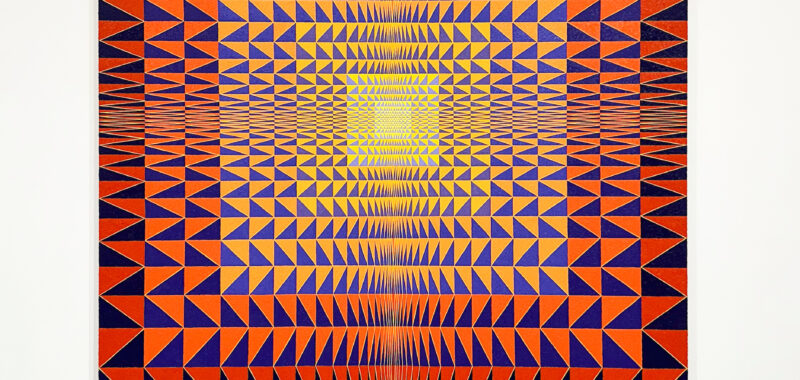LOS ANGELES — The Open Window, Brooklin A. Soumahoro’s current exhibition at François Ghebaly gallery, takes its title from Matisse’s Fauvist work “Open Window, Collioure” (1905). In Matisse’s painting, we see the Mediterranean coast through an open window. The artist renders each area of the picture — interior, balcony, seascape — with different brush strokes in high-key colors, creating a visual polyrhythm within the overall architecture of the composition. The window-in-a-painting format is a classic trope that enables the window’s rectangular form to function as a portal into the illusory space of the image while simultaneously emphasizing the flatness of the picture plane. It allows for two spaces, exterior and interior, to exist concurrently and for two different lighting conditions, the latter perhaps most relevant to Soumahoro’s dazzling new paintings.
Soumahoro’s pieces all share the same composition and structure: a series of concentric rectangles, or windows, filled with a pattern of alternating right triangles. The triangles become increasingly squished and squeezed as they approach the central vertical and horizontal axes, resulting in a spatial illusion that draws the eye toward and into the center of the painting. They feel like visual asymptotes, producing a constant sense of movement toward an imagined endpoint but never quite getting there. The near-consistency among the works allows viewers to notice the different ways that the artist’s carefully calibrated color relationships inspire different sensations. The dark purples, oranges, and reds in “Window, Orn/Prl.1.24” (2024) evoke a blazing sunset, while the atmosphere of “Window, Red/Ble.1.24” (2024) feels moody and mysterious. Some of the most compelling moments in these paintings are when the outlines of the triangles, particularly those whose colors contrast with the rest of the painting, shift from background to foreground as they approach the center of the picture plane.

The press release credits a diverse array of influences on Soumahoro: Sol Lewitt, Agnes Martin, and West Indian textile traditions, to name a few, but I also see the Flying Geese pattern from American quilt making traditions and the designs of both Anni and Josef Albers. Of course, many visual traditions incorporate the eye-pleasing motif of repeated triangles, so these references are less a comment on the artist’s intentions and influences and more a testament to the way that abstraction can act as a window that we view through the lens of our own unique aesthetic experiences and inheritances.
Soumahoro’s paintings are the result of a meticulous, labor-intensive process, involving detailed preliminary studies, a precise understanding of color, and exacting brush handling. The great surprise is how all that labor seems to disappear in the artist’s hands. While the paint handling is not extremely thick, the textured brushiness allows light to bounce off the surface to shimmering effect. These luminous paintings are filled with moments of alchemy, transforming discipline into grace, the two dimensional into the three dimensional, and shape into line. Rather than feeling tight and controlled, the works are open and expansive, filled with room to breathe. But ultimately they are about the quality that has enchanted painters for centuries — how paint can transform into light.





Brooklin A. Soumahoro: The Open Window continues at François Ghebaly gallery (2245 East Washington Boulevard, Downtown, Los Angeles) through October 12. The exhibition was organized by the gallery.

